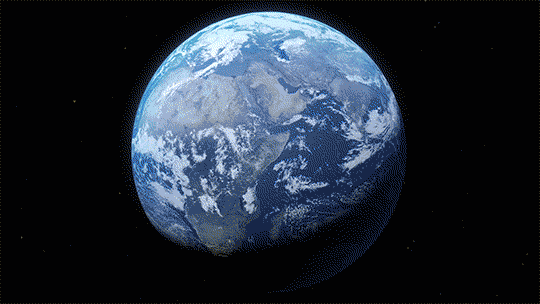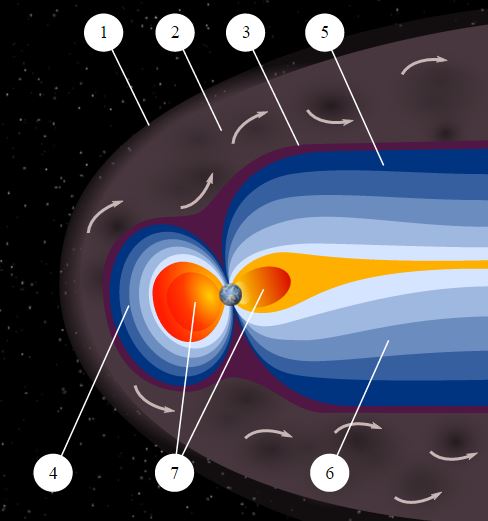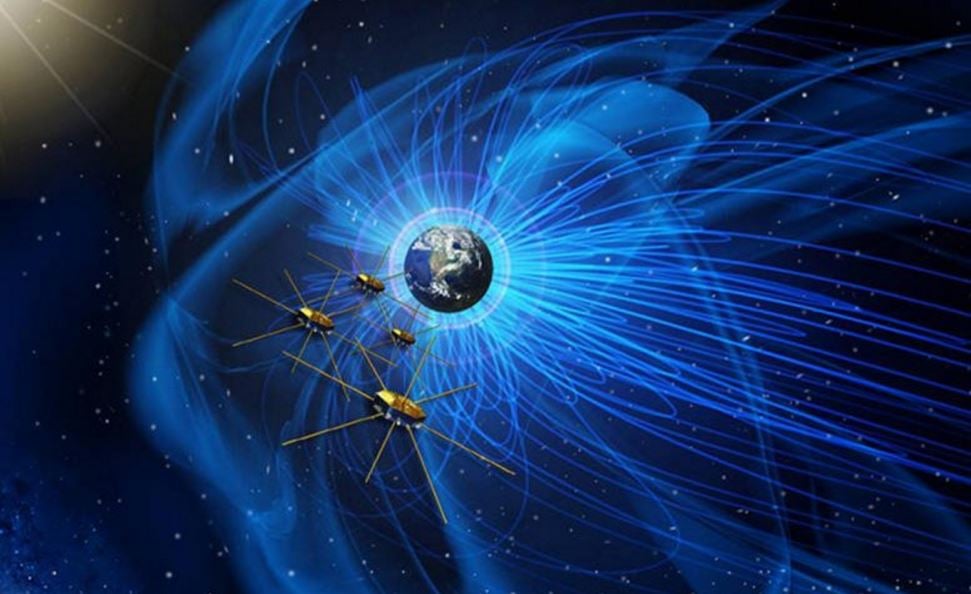The mysterious way that the magnetic explosions resulting from interactions between the magnetic fields of the Sun and Earth occur are being observed for the first time by a fleet of NASA spacecraft. These interactions can disrupt power grids on Earth, our satellites and spacecraft, as well as endangering the lives of astronauts.
It is a bit like sending sensors into a hurricane. In this case, NASA has flown four spacecraft through the magnetic reconnection, one of the prime drivers of space radiation, in a quest to learn more about our space environments and protect our astronauts and spacecraft as we venture farther and farther from Earth – our home planet.
Even though space is a vacuum, more ‘empty’ than anything we are able to create on Earth, it does contain some particles – in fact, it is bustling with activity.
 The 4 Magnetospheric Multiscale (MMS) spacecraft have now made over 4,000 trips through the boundaries of Earth’s magnetic field, gathering observations of our dynamic space environment. (Image: nasa.gov. Credits: NASA/Goddard/Conceptual Image Lab)
The 4 Magnetospheric Multiscale (MMS) spacecraft have now made over 4,000 trips through the boundaries of Earth’s magnetic field, gathering observations of our dynamic space environment. (Image: nasa.gov. Credits: NASA/Goddard/Conceptual Image Lab)
Space has a complex system of magnetic fields
Space is overflowing with energy and has a complex system of magnetic fields. When two sets of magnetic fields connect, an explosive reaction sometimes occurs. As the two magnetic fields re-align and snap into a new formation they give off particles that zoom off in jets.
An article published in the journal Science (citation below) provides the first observations within a magnetic reconnection event.
Lead author, Jim Burch, principal investigator for MMS at the Southwest Research Institute in San Antonio, Texas, and colleagues explained that the research shows that magnetic reconnection is dominated by the physics of electrons – thus providing vital data on what powers this fundamental process in nature.
The effects of this sudden energy or particle release – such as the aurora, the giant eruptions on the Sun’s surface, radiation storms in near-Earth space, and high-energy cosmic particles originating from other galaxies – have been observed throughout the solar system and elsewhere.
 Magnetic reconnection — a phenomenon that occurs throughout space — happens when magnetic field lines come together, realign and send particles hurling outward. (Image: nasa.gov. Credits: NASA/Goddard/Conceptual Image Lab)
Magnetic reconnection — a phenomenon that occurs throughout space — happens when magnetic field lines come together, realign and send particles hurling outward. (Image: nasa.gov. Credits: NASA/Goddard/Conceptual Image Lab)
Seeing the magnetic reconnection itself
However, nobody has ever been able to witness the phenomenon of magnetic reconnection directly. Our satellites have caught tantalizing glimpses of particles speeding by, but not the impetus – a bit like when you want to observe a tornado and all you see is the debris flung out, but never the storm itself.
Dr. Burch, who is Vice President of the Southwest Research Institute’s Space Science & Engineering Division, said:
“We developed a mission, the Magnetospheric Multiscale (MMS) mission, that for the first time would have the precision needed to gather observations in the heart of magnetic reconnection.”
“We received results faster than we could have expected. By seeing magnetic reconnection in action, we have observed one of the fundamental forces of nature.”
MMS consists of four identical spacecraft that lifted off in March last year. They create a full 3-dimensional map of any phenomena they observe by flying in a pyramid formation.
On 16th October, 2015, the four spacecraft travelled directly through a magnetic reconnection event at the boundary where the Earth’s and Sun’s magnetic fields bump into each other.
In just a few seconds, the twenty-five sensors on each spacecraft collected thousands of observations.
NASA wrote:
“This unprecedented time cadence opened the door for scientists to track better than ever before how the magnetic and electric fields changed, as well as the speeds and direction of the various charged particles.”
The science of reconnection springs from the fundamental science of electromagnetics, which dominates most of what goes on in our Universe, and is a force as fundamental in space as gravity is on our planet.
 The vacuum in space is better than any vacuum we are able to create on Earth. However, it’s bustling with activity, particles and magnetic field lines. NASA studies the space environment to protect our technology and astronauts as we all explore farther and farther away from our home planet. (Image: nasa.gov. Credits: NASA/Goddard/Conceptual Image Lab)
The vacuum in space is better than any vacuum we are able to create on Earth. However, it’s bustling with activity, particles and magnetic field lines. NASA studies the space environment to protect our technology and astronauts as we all explore farther and farther away from our home planet. (Image: nasa.gov. Credits: NASA/Goddard/Conceptual Image Lab)
Where do magnetic reconnections occur?
Think of any set of magnetic fields as a row of lines. The field lines are always anchored to some kind of body – perhaps a star or a planet – creating a massive magnetic network surrounding it.
Magnetic reconnections occur at the boundaries of two such networks.
Imagine at such a boundary, rows of magnetic field lines moving towards each other – the boundary that MMS travels through, for instance, is one where the Sun’s field meets the Earth’s.
Sometimes the field lines are travelling in the same direction, and do not have much of an effect on each other, like two currents of water flowing in the same direction, side by side.
However, if the two sets of field lines are moving in opposite directions, the process of realigning is spectacular. It may be massively explosive, with particles hurled away at near light speed. It might also be slow and steady. Either way, a colossal amount of energy is released.
 An artist’s impression of the structure of a magnetosphere: 1. Bow shock. 2. Magnetosheath. 3. Magnetopause. 4. Magnetosphere. 5. Northern tail lobe. 6. Southern tail lobe. 7. Plasmasphere. (Image: Wikipedia)
An artist’s impression of the structure of a magnetosphere: 1. Bow shock. 2. Magnetosheath. 3. Magnetopause. 4. Magnetosphere. 5. Northern tail lobe. 6. Southern tail lobe. 7. Plasmasphere. (Image: Wikipedia)
Why are magnetic reconnections not always explosive?
Tom Moore, the mission scientist for MMS at NASA’s Goddard Space Flight Center in Greenbelt, Maryland, said:
“One of the mysteries of magnetic reconnection is why it’s explosive in some cases, steady in others, and in some cases, magnetic reconnection doesn’t occur at all.”
Whether steady or explosive, the local particles are caught up in the event, flung to areas far away, crossing magnetic boundaries that they could never otherwise have done.
At the edges of Earth’s magnetosphere, such events allow solar radiation to enter near-Earth space. The magnetosphere is Earth’s magnetic environment – the region surrounding the Earth where its magnetic field dominates, rather than the magnetic field of interplanetary space.
Dr. Burch said:
“From previous satellites’ measurements, we know that the magnetic fields act like a slingshot, sending the protons accelerating out. The decades-old mystery is what do the electrons do, and how do the two magnetic fields interconnect.”
“Satellite measurements of electrons have been too slow by a factor of 100 to sample the magnetic reconnection region. The precision and speed of the MMS measurements, however, opened up a new window on the universe, a new ‘microscope’ to see reconnection.”
 Another artist’s impression of the four craft of NASA’s Magnetospheric Multiscale mission flying in formation in and out of Earth’s magnetosphere, probing the phenomenon of magnetic reconnection. (Image: sciencemag.org)
Another artist’s impression of the four craft of NASA’s Magnetospheric Multiscale mission flying in formation in and out of Earth’s magnetosphere, probing the phenomenon of magnetic reconnection. (Image: sciencemag.org)
With this new set of observations, MMS tracked what occurs to electrons during a magnetic reconnection. As the four spacecraft travelled across the magnetosphere’s boundary, they flew directly through the dissipation region where magnetic reconnection took place.
They were able to observe and track how the magnetic fields suddenly shifted, as well as how the particles moved away.
According to the observation data, the electrons shot away in straight lines from the original event at several hundred miles per second, crossing the magnetic boundaries that would usually deflect them.
As soon as they were across the boundary, the particles curved back around in response to the new magnetic field they encountered, making a U-turn. These observations matched what a computer simulation – the crescent model – had predicted.
The model is named for the characteristic crescent shapes that the graphs show to depict how far across the magnetic boundary the electrons may be expected to travel before doing a U-turn.
The scientists were surprised to find that at the moment of interconnection between the magnetic field lines of the Sun and Earth, the crescents turned abruptly so that the electrons flowed along the field lines.
By observing these electron tracers, MMS made the first observation of the predicted breaking and interconnection of magnetic fields in outer space.
Michael Hesse, a space scientist at Goddard who first developed the computer simulation (crescent model), said:
“The data showed the entire process of magnetic reconnection to be fairly orderly and elegant. There doesn’t seem to be much turbulence present, or at least not enough to disrupt or complicate the process.”
The persistent characteristic crescent shape in the electron distribution suggests that the physics of electrons is at the heart of understanding how magnetic field lines accelerate the particles.
Co-author, Roy Torbert, a scientist at the Space Science Center at the University of New Hampshire in Durham, said:
“This shows us that the electrons move in such a way that electric fields are established and these electric fields in turn produce a flash conversion of magnetic energy. The encounter that our instruments were able to measure gave us a clearer view of an explosive reconnection energy release and the role played by electron physics.”
MMS has so far made over 4,000 trips through the magnetic boundaries around Earth, each time collecting data about how the magnetic fields and particles move.
After its direct observation of magnetic reconnection, MMS has flown through such an event another five times, providing more data about this fundamental process.
The scientists plan to adjust the formation of the MMS spacecraft. Bringing them closer together would provide better viewing of electron paths, while pushing them further apart would provide a better viewing of the proton paths.
Each set of observations helps explain the different aspects of magnetic reconnection. Together, the data will help researchers map out details of our space environment – vital information as humans venture further out into space.
In an Abstract in the journal the authors wrote:
“We have (i) observed the conversion of magnetic energy to particle energy, (ii) measured the electric field and current, which together cause the dissipation of magnetic energy, and (iii) identified the electron population that carries the current as a result of demagnetization and acceleration within the reconnection diffusion/dissipation region.”
Citation: “Electron-scale measurements of magnetic reconnection in space,” W. Lewis, Y. Saito, V. Coffey, M. Chandler, J. L. Burch, R. B. Torbert, T. D. Phan, L.-J. Chen, T. E. Moore, R. E. Ergun, K. J. Trattner, B. Lavraud, P. H. Reiff, W. Baumjohann, W. Magnes, M. Steller, J. P. Eastwood, D. J. Gershman, P. A. Cassak, M. R. Argall, S. Wang, M. Hesse, C. J. Pollock, B. L. Giles, R. Nakamura, B. H. Mauk, S. A. Fuselier, C. T. Russell, R. J. Strangeway, J. F. Drake, M. A. Shay, Yu. V. Khotyaintsev, P.-A. Lindqvist, J. F. Fennell, J. B. Blake, J. Clemmons, M. Goldman, D. Newman, S. M. Petrinec, G. Marklund, F. D. Wilder, D. T. Young, K. Torkar, J. Goldstein, J. C. Dorelli, L. A. Avanov, M. Oka, D. N. Baker, A. N. Jaynes, K. A. Goodrich, I. J. Cohen & D. L. Turner. Science. 12 May 2016. DOI: 10.1126/science.aaf2939.
MMS captures magnetic reconnection in action
This NASA Goddard video explains how the four NASA spacecraft captured a magnetic reconnection in action.
